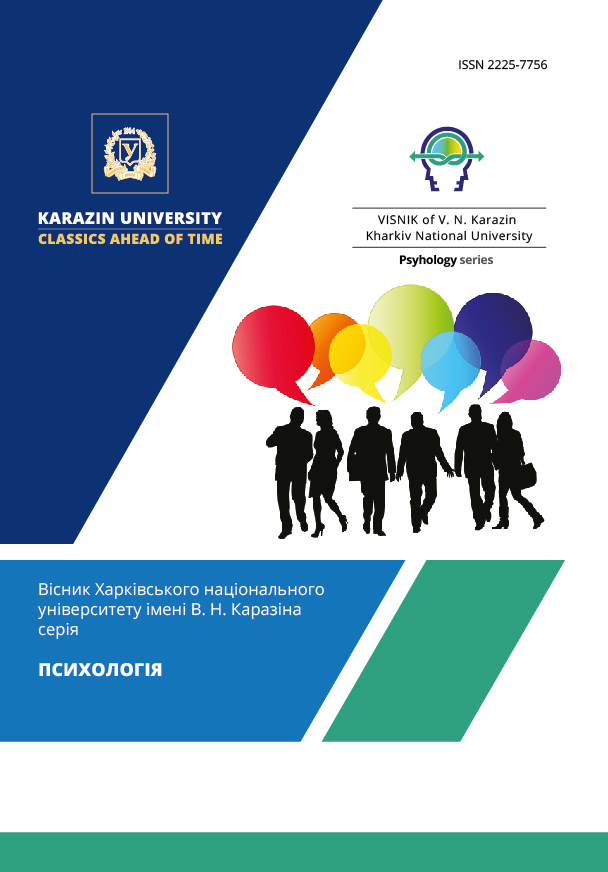The Qualities of Romantic Relationships and Emotional Creativity of Hetero- and Homosexual Couples Representatives - Do They Love Differently in the Female Sexual Minority?
Abstract
Studies of the characteristics of hetero- and homosexual couples relationships are fragmentary. Modern Ukrainian society remains insufficiently aware of this issue, which leads to the stigmatization of a person because of his sexual orientation. The purpose of our study was to determine the relationship between emotional creativity and the quality of love relationships in hetero- and homosexual couples. The sample consisted of 20 heterosexual and 20 homosexual female couples (60 women and 20 men) aged 18-40. R. Sternberg's "Triangular Scale of Love", J. Avrill's questionnaire "Emotional Creativity", S. Khedrik's and K. Khedrik's "Psychological Types of Love" questionnaire, T. Rumyantseva's "Circle of Relationships" projective method (2006) were used for diagnosis. It was found out that regardless of sexual orientation, partners in romantic relationships are characterized by the same pronounced emotional creativity and have the similar quality of love relationships. It was determined that love-friendship prevails in all pairs, they also have partially symbiotic relationships, which are more pronounced in some heterosexual couples. Homosexual couples are characterized by more symmetrical relationships, although, as in heterosexual couples, there is a reaction of alienation in response to an attempt to build a symbiotic relationship by another partner. The revealed connections of emotions novelty with love obsession in lesbians and love pragmatism in heterosexual couples indicate the specificity of this emotional creativity component manifestation depending on the sexual orientation of the couples.
Downloads
References
Andreyeva, I. N. (2011). Adaptation of the emotional creativity questionnaire (ECI). Psikhologicheskiy zhurnal, (1-2), 75-81. [in Ukrainian]
Andreyeva, I.N. (2006). Emotional creativity and its differences from emotional intelligence. Visnik Chernigivs'kogo derzhavnogo pedagogichnogo universitetu imeni T.G. Shevchenka. Vip. 41. Seriya: Psikhologichni nauki. (1), 13-15. [in Russian]
Bem, S. L. (2004). Lenses of gender: Transformation of views on the problem of gender inequality. M.: Rossiyskaya politicheskaya entsiklopediya, 336. [in Russian]
Bryant, A. S. (1994). Demian Relationship Characteristics of American Gay and Lesbian Couples: Findings from a National Survey. Journal of Gay & Lesbian Social Services, 1, 101-117.
Derevyanko, S. P. (2017). The role of emotional creativity in the choice of coping strategies. Vestnik Polotskogo gosudarstvennogo universiteta. Ser. E, Pedagogicheskiye nauki, (7), 87–91. [in Russian]
Derevyanko, S. P., Kondratenko, Ye. Ye. (2021). Functions of emotional creativity in professional activity. Kollokvium, (2), 7 9. [in Russian]
Frolova, S. V. (2020). Essential characteristics and methods for diagnosing types of love. Izvestiya Saratovskogo universiteta. Ser. Filosofiya. Psikhologiya. Pedagogika, (4), 439-448. [in Russian]
Kocharyan, A. S., Hlushchenko, L. V. (2009). The connection between the image of the father and the image of the marital partner. Visnyk Kharkivsʹkoho natsionalʹnoho universytetu imeni V.N. Karazina. Seriya: «Psykholohiya», (842), (41), 160-165. [in Ukrainian]
Kotel'nikova, Yu. S. (2017). Satisfaction with marriage and family relations in young families. Psikhologiya. Istoriko-kriticheskiye obzory i sovremennyye issledovaniya, 6(2A), 181-190. [in Russian]
Kravchuk, A. (2017). Traditional orientation. Myths and facts about LGBT people. Kyiv: Tsentr “Nash svit”, 78. [in Ukrainian]
Kurdek, L. A. (2005). What do we know about gay and lesbian couples? Current Directions in Psychological Science, 14(5), 251–254. https://doi.org/10.1111/j.0963-7214.2005.00375.x
Lutsenko, O., & Gabelkova, O. (2021). Relationship between life planning and the level of neuroticism in women of different sexual orientations. Problems of Political Psychology, 24 (1), 257-272. https://doi.org/10.33120/popp-Vol24-Year2021-79.
Lutsenko, O., Kreydun, N., Nalivayko, O. (2021). Career orientations and professional responsibility of Ukrainian women with different sexual orientations. Are sexual minorities worse adapted to professional activities? International Conference on Social Science, Psychology and Legal Regulation, Kyiv, Ukraine, 22-23 December, 2021. Part of series ASSEHR, 617, 113 118. https://doi.org/10.2991/assehr.k.211218.019
Lutsenko, Ye. L. (2015). Sexual and love addiction: phenomenology, psychophysiological basis, methods of correction (review). Vestnik psikhofiziologii, (3), 21-36. [in Russian]
Maslou, A. (2019). Motivation and personality. SPb.: Piter, 400. [in Russian]
Patterson, C. J., Sutfin, E. L., Fulcher, M., (2004). Division of Labor Among Lesbian and Heterosexual Parenting Couples: Correlates of Specialized Versus Shared Patterns. Journal of Adult Development, (3),179–189.
Romankiv, N. A., Lutsenko, Ye. L. (2012). Features of projective self-identification of women with non-traditional sexual orientation. Gendernyye aspekty gumanitarnykh nauk: materialy II mezhdunarodnoy zaochnoy nauchno-prakticheskoy konferentsii . Novosibirsk: SibAK, 19-23. [in Russian]
Rumyantseva, T. V. (2006). Psychological counseling: diagnosis of relationships in a couple. Navchalʹnyy posibnyk. SPb.: Rechʹ, 176. [in Ukrainian]
Zimovin, O. I. (2018). Double sexual standards of spouses as a factor of dissatisfaction with marriage. Naukovyy visnyk Khersonsʹkoho derzhavnoho universytetu, 2(1), 131-136. [in Ukrainian]




